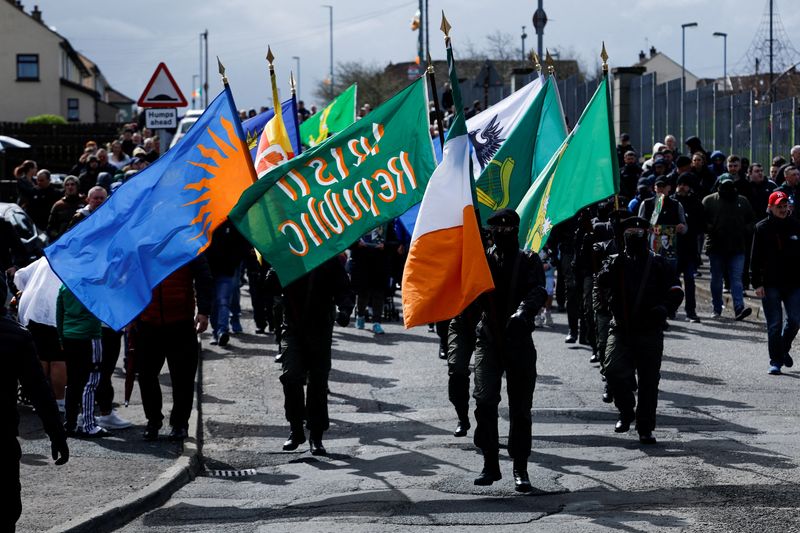(Reuters) - The Good Friday Agreement largely ended the "Troubles", three decades of violence that had racked Northern Ireland since the late 1960s. It was signed on April 10, 1998 - which fell that year on Good Friday in the Christian Easter holiday.
WHAT WERE THE 'TROUBLES'?
After the partition of Ireland in the 1920s, divisions remained in the British province between republicans, who wanted a united Ireland, and unionists, who supported British rule.
Republicans, and the broader nationalist community, are mostly Catholic, while unionists, who were in the majority and so controlled the local government, are largely Protestant.
Conflict erupted amid sectarian rioting in Belfast and elsewhere in the late 1960s, partly triggered by an emerging Catholic civil rights movement.
More than 3,600 people were killed over the next 30 years, mostly by paramilitary groups on both sides such as the Irish Republican Army (IRA) and pro-British Protestant groups usually known as "loyalists".
Some people were also killed by the British army - which had been deployed in 1969 and soon became the target for attacks by the IRA and other republican groups - and local security forces.
HOW DID THE AGREEMENT COME ABOUT?
Peace initiatives and back-channel talks on ending the violence began in the 1980s, though progress was slow.
In 1994 the major paramilitary groups on both sides declared ceasefires. The IRA ended its ceasefire in 1996, blaming Britain for a lack of progress, while the loyalist ceasefires were frequently breached.
But momentum picked up with the election in Britain of Tony Blair's Labour government in 1997. The IRA called a new ceasefire in July that year and talks began in September.
The talks frequently appeared to be on the brink of collapse. Blair and Irish Prime Minister Bertie Ahern joined the participants at Stormont during the final days, with negotiations running through the night from Thursday, April 9.
WHO TOOK PART IN THE TALKS?
The talks involved the British and Irish governments and eight Northern Ireland political parties, the largest of which were the Ulster Unionist Party (UUP), which had ruled Northern Ireland from partition until the imposition of direct rule from London in 1972, and the nationalist Social Democratic and Labour Party (SDLP).
UUP leader David Trimble and SDLP leader John Hume would later share the Nobel Peace Prize.
Paramilitary groups were excluded, but two small unionist parties linked to loyalist groups and the IRA's political ally Sinn Fein, led by Gerry Adams and Martin McGuinness, took part.
The Democratic Unionist Party (DUP) was the only mainstream political party that did not participate, after walking out over the inclusion of Sinn Fein.
U.S. President Bill Clinton was supportive and sent former Senate Majority Leader George Mitchell to chair the negotiations.
WHAT DID THE AGREEMENT SAY?
The deal was formally two interlinked agreements: a treaty between the British and Irish governments and an agreement between the Northern Irish parties.
It acknowledged Northern Ireland's constitutional status as part of the United Kingdom, but also the principle of consent - that a united Ireland could come about if a majority of people in both jurisdictions on the island voted for it.
Britain committed to holding a referendum if it appeared likely that a majority might vote for Irish unity, while Ireland agreed to amend its constitution to remove its territorial claim to Northern Ireland.
A powersharing assembly and executive were set up, establishing a local government at Stormont, on the outskirts of Belfast, that required the participation of parties from both sides.
"North-south" bodies were created to encourage cooperation between Northern Ireland and Ireland, while "east-west" institutions linked Britain and Ireland.
Other sections of the agreement dealt with reform of the Protestant-dominated police force, the early release of paramilitary prisoners, the disarmament of paramilitary groups and the "normalisation" of security arrangements.
The agreement was endorsed by referendums on both sides of the Irish border in May 1998.
HOW HAS IT WORKED OUT?
Overall, Northern Ireland has enjoyed peace for much of the 25 years since the agreement was signed, with only a small number of splinter groups involved in sporadic attacks.
But parts of the agreement are vague - talks veterans refer to the "constructive ambiguity" required to forge a deal that one side could sell to its supporters as a step towards a united Ireland while the other could paint as securing Northern Ireland's future in the United Kingdom.
That has contributed to difficulties in implementing it.
Powersharing has broken down on several occasions over the inability of rival parties to work together, leading to lengthy suspensions of the assembly. It collapsed again last year over post-Brexit trade rules.
WHAT HAS THE AGREEMENT GOT TO DO WITH BREXIT?
Britain's departure from the European Union - and its single market and customs union - has created a problem for Northern Ireland by raising the prospect of a "hard border" with EU-member Ireland.

For nationalists, any imposition of border checks would contravene one of the agreement's core tenets of fostering north-south cooperation.
Unionists say the Northern Ireland protocol - a Brexit workaround that imposed checks on goods moving between Northern Ireland and the rest of the United Kingdom - has put a border in the Irish Sea, undermining Northern Ireland's place in the Union.